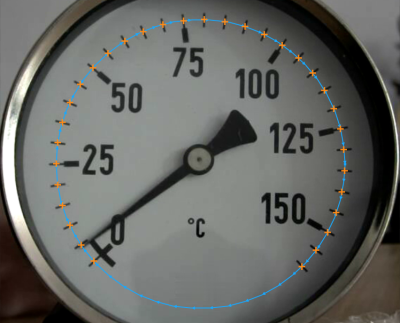You are here: Start » AVL.NET » AVL.ScanMultipleRidges(AvlNet.Image, AvlNet.ScanMap, AvlNet.RidgeScanParams, float, float?, AvlNet.LocalBlindness, AvlNet.Ridge1D[], AvlNet.Gap1D[], AvlNet.Profile, AvlNet.Profile)
AVL.ScanMultipleRidges(AvlNet.Image, AvlNet.ScanMap, AvlNet.RidgeScanParams, float, float?, AvlNet.LocalBlindness, AvlNet.Ridge1D[], AvlNet.Gap1D[], AvlNet.Profile, AvlNet.Profile)
Locates multiple dark or bright pixel peaks along a given path.
| Namespace: | AvlNet |
|---|---|
| Assembly: | AVL.NET.dll |
Syntax
public static void ScanMultipleRidges( AvlNet.Image inImage, AvlNet.ScanMap inScanMap, AvlNet.RidgeScanParams inRidgeScanParams, float inMinDistance, float? inMaxDistance, AvlNet.LocalBlindness inLocalBlindness, out AvlNet.Ridge1D[] outRidges, out AvlNet.Gap1D[] outGaps, out AvlNet.Profile diagBrightnessProfile, out AvlNet.Profile diagResponseProfile )
Parameters
- inImage
- Type: AvlNet.Image
Input image - inScanMap
- Type: AvlNet.ScanMap
Data precomputed with CreateScanMap - inRidgeScanParams
- Type: AvlNet.RidgeScanParams
Parameters controlling the ridge extraction process - inMinDistance
- Type: System.Single
Minimal distance between consecutive ridges - inMaxDistance
- Type: System.Nullable<System.Single>
Maximal distance between consecutive ridges, or null. - inLocalBlindness
- Type: AvlNet.LocalBlindness
Defines conditions in which weaker ridges can be detected in the vicinity of stronger ridges, or null. - outRidges
- Type: AvlNet.Ridge1D
Found ridges - outGaps
- Type: AvlNet.Gap1D
Gaps between consecutive ridges - diagBrightnessProfile
- Type: AvlNet.Profile
Extracted image profile - diagResponseProfile
- Type: AvlNet.Profile
Profile of the ridge operator response
Description
The operation scans the image using inScanMap previously generated from a scan path and detects ridges. Depending on the inRidgeScanParams.ridgePolarity parameter, dark, bright or both ridges will be taken into account.
When the number of ridges to be measured is known, one can use the ScanExactlyNRidges filter.
Note that in case of a scan path which is closed, the parameters controlling the distances between consecutive found objects do not control the distance between the first and the last of the found objects (counting from the beginning of the scan path).
Examples

ScanMultipleRidges locates the ridges using a scan map representing the scan path above.
Remarks
For more information about local coordinate systems please refer to the following article.
This filter is a part of the 1D Edge Detection toolset. For a comprehensive introduction to this technique please refer to 1D Edge Detection and 1D Edge Detection - Subpixel Precision chapters of our Machine Vision Guide.


